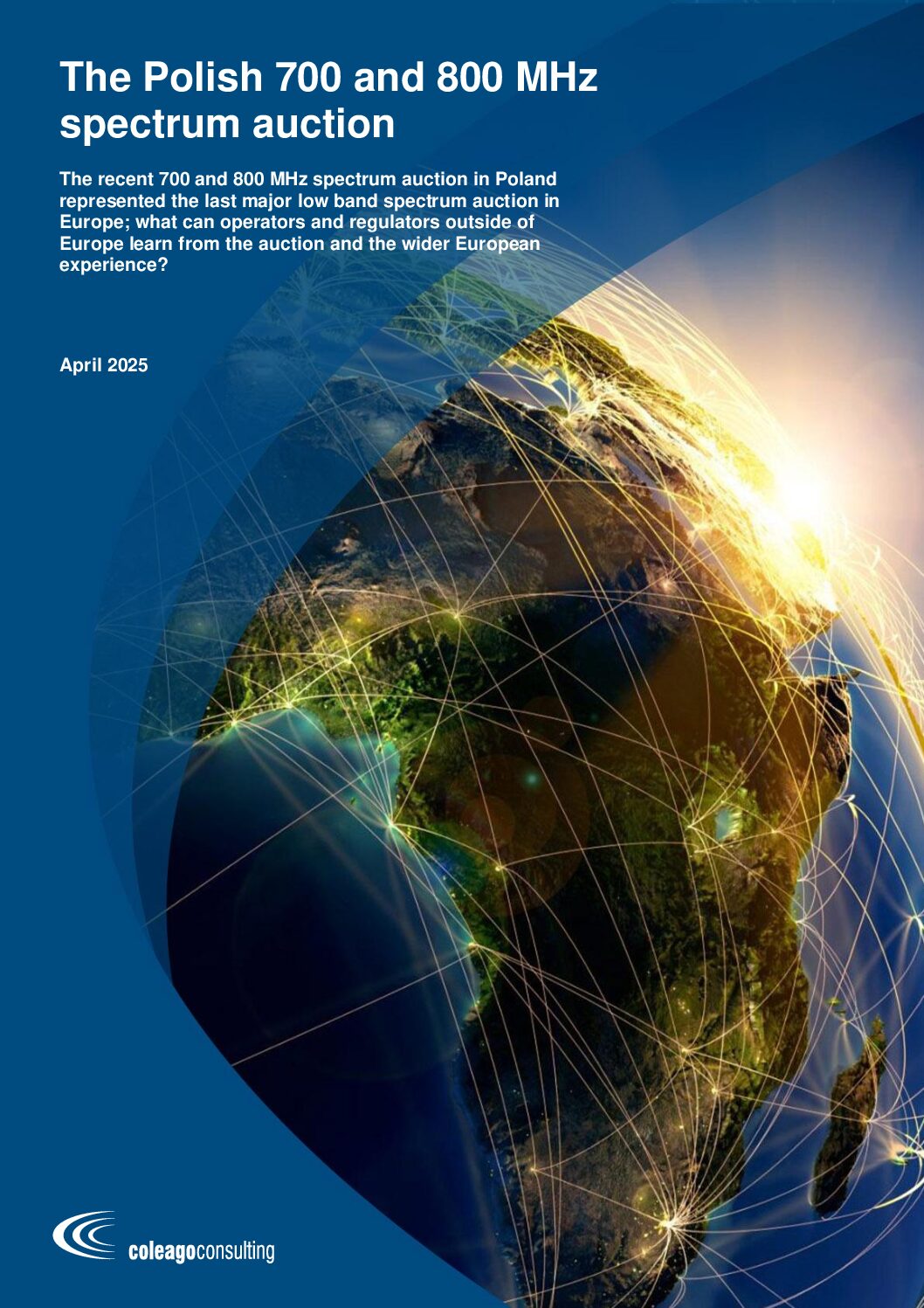The Polish 700 and 800 MHz Spectrum Auction: Insights and Global Lessons
Poland’s final low-band spectrum auction marks a pivotal moment in Europe’s 5G rollout, offering key lessons in auction design, cross-border coordination, and strategic spectrum management.
In March 2025, Poland’s Office of Electronic Communications (UKE) concluded a landmark spectrum auction, allocating six 2 × 5 MHz blocks in the 700 MHz band and one 2 × 5 MHz block in the 800 MHz band. As one of the final major low-band auctions in the European Union, this event serves not only as a national milestone but also as a capstone to Europe’s coordinated decade-long reallocation of sub-1 GHz spectrum to support next-generation mobile services, particularly 5G.

Key Auction Outcomes
- Auction Structure: The auction followed a Simultaneous Multi-Round Ascending (SMRA) format and concluded in just two days with winning bids only 3.6% above the reserve prices, suggesting a low-competition environment or effective price anchoring.
- Operators and Allocations: Four major operators participated, with Orange and P4 securing two blocks each, while T-Mobile and Polkomtel secured just one. This outcome raised questions about potential strategic bidding miscalculations or deliberate cost-saving tactics, especially given that a single 2×5 MHz block is generally viewed as suboptimal for 5G deployment.
- Price Uniformity: Despite potential interference differences between blocks, prices remained nearly uniform, pointing to limited bidder differentiation between spectrum positions.
Related insights
Strategic and Technical Considerations
- Exposure Risk: The use of 2×5 MHz lots increased the risk of operators being “stranded” with an unprofitable allocation if they failed to secure adjacent blocks. This scenario likely affected T-Mobile and Polkomtel, and underscores the need for careful auction design to minimize such risks.
- Cross-Border Interference: Ongoing usage of adjacent frequencies by broadcasters in Ukraine and Belarus presents interference risks. While Poland has pursued coordination with Ukraine, Belarus remains a significant challenge.
- Deployment Risks: T-Mobile’s combined holding of 700 and 800 MHz may lead to passive intermodulation (PIM) interference, complicating efforts to deploy advanced low-band MIMO technologies without additional engineering mitigation.
Broader European and Global Lessons
Drawing from this and similar European auctions, the report outlines several critical insights for spectrum regulators and telecom operators worldwide:
- Market Readiness Matters: Spectrum should be released in line with device availability, market maturity, and network readiness to ensure successful integration into existing and future mobile infrastructure.
- Holistic Spectrum Management: Regulators are encouraged to adopt a band-agnostic approach to sub-1 GHz spectrum—700, 800, and 900 MHz are increasingly seen as interchangeable, allowing for more flexible and efficient network planning.
- Reserve Pricing Strategy: High reserve prices have led to auction failures in some countries (e.g., Romania). Poland’s moderate pricing approach is presented as a model for striking a balance between revenue generation and market viability.
- Support for Secondary Markets: The ability to trade or lease spectrum post-auction (as seen in the UK and Netherlands) allows operators to optimize holdings and avoid inefficiencies from suboptimal auction outcomes.
- Creative Rural Coverage Policies: As deep rural coverage is costly and prone to natural monopolies, solutions such as national roaming agreements or coverage-linked discounts are recommended.
- Technology Neutrality: Licenses should permit spectrum use across current and future technologies (4G, 5G, 6G), promoting long-term efficiency and adaptability.
Other insights

The European 5G Fairytale
For years, European policymakers and telecom operators have touted the impressive figure: “89% 5G coverage of populated areas.” On paper, this paints a picture of near-ubiquitous, high-speed connectivity. Scratch the surface however, and the reality looks quite different.

Maximising Shareholder Value in Spectrum Auctions
Spectrum auctions, while common in the telecom industry, are complex and high-risk events that can significantly influence a company’s long-term performance. Missteps, especially vague auction objectives and poor valuation discipline, can lead to substantial destruction of shareholder value.

Spectrum and Regulatory Challenges Related to eVTOLS
Electric Vertical Take-Off and Landing (eVTOL) aircraft are poised to revolutionise urban mobility, with commercial operations expected to begin as early as 2025 and significant growth anticipated by the 2030s.

Future of the UHF Band after 2024: An Analysis of Options in the UK
Coleago Consulting in collaboration with its client, the UK Spectrum Policy Forum, has released a landmark report, “Future of the UHF Band After 2034,” setting out a detailed assessment of the United Kingdom’s Ultra High Frequency (UHF) spectrum landscape. The report looks at the industry trends and the critical trade-offs required to balance the needs of Digital Terrestrial Television (DTT), Mobile Communications, and Programme Making and Special Events (PMSE).

The Case for Strategic Spectrum Renewal
As spectrum licences approach their expiry date, a strategic approach to spectrum renewal is crucial. Traditional presumption of renewal in favour of incumbents may no longer serve the industry’s needs. Instead, a more strategic approach to renewal can optimise spectrum assignments and improve spectral efficiency by up to 40%.

Best Practice Spectrum Management
The principles of best practice spectrum management are well established and their implementation can enhance the socio-economic value of spectrum and how much operators are prepared to pay to acquire new spectrum. Whilst most regulators in developed markets have adopted best practice, the same cannot be said for developing markets. Coleago recently studied the regulatory environments in 16 African markets and recorded the extent to which best practice had been adopted.